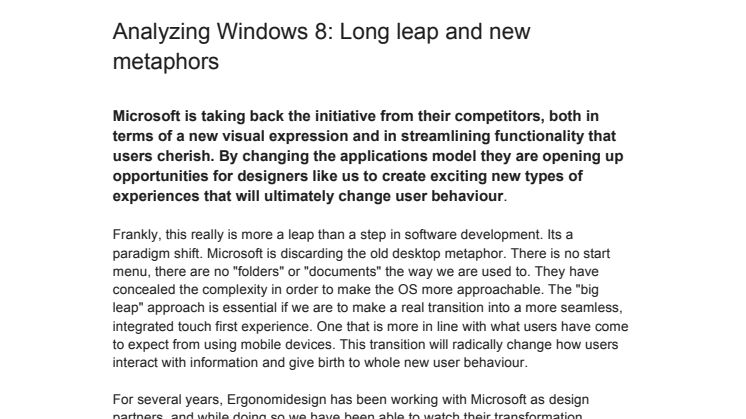Nyhet -
Analyzing Windows 8: Long leap and new metaphors
Microsoft is taking back the initiative from their competitors, both in terms of a new visual expression and in streamlining functionality that users cherish. By changing the applications model they are opening up opportunities for designers like us to create exciting new types of experiences that will ultimately change user behavior.
Frankly, this really is more a leap than a step in software development. Its a paradigm shift. Microsoft is discarding the old desktop metaphor. There is no start menu, there are no "folders" or "documents" the way we are used to. They have concealed the complexity in order to make the OS more approachable. The "big leap" approach is essential if we are to make a real transition into a more seamless, integrated touch first experience. One that is more in line with what users have come to expect from using mobile devices. This transition will radically change how users interact with information and give birth to whole new user behaviour.
For several years, Ergonomidesign has been working with Microsoft as design partners, and while doing so we have been able to watch their transformation process courtside. We have developed apps and strategies for banking services, video services, the ever so popular swedish music service. Its clear to us that working with the metro interface and now the W8 OS means a new mindset for the users.
To many, Apple’s products have become synonymous with usability. But despite their popularity, the design world has becoming more and more critical of Apple’s use of skeuomorphic interfaces that build on antiquated metaphors and a superfluous use of visual treatments. Microsoft’s new OS takes a completely new direction, it does away with excess treatments and physical metaphors and instead leans on typography and allows objects to suggest their action. The approach builds on a belief that users have become accustomed to touch interfaces and have learned what to expect, thus knowing which actions are possible and in which situations. It is a leap forward, a lot more than one or two small tweaks; for a huge number of users. And it is up to us designers to understand the users and see their challenges so we can create the right designs. But if you look beyond the visuals, there is more.
One of the most exciting opportunities for designers and service creators is the use of "contracts". Using “contracts” puts an end to the current apps-as-isolated-islands convention, by allowing information to be exchanged between apps. This change is unique in the sense that, in a simple way, it allows services to utilize the strength of other services to make its content richer and become more relevant to the user. This potentially allows a service to focus on the core experience while at the same time offering access to related information through other services. Surely they are onto something game changing here, enabling use cases that were not originally intended. For instance, a music app can focus on the music and utilize the bios from another app that specializes in precisely bios.
In the current model for SW applications, users are confined to the boundaries of each app. This is true for both iOS and Android. Aggregating content from other apps is possible, sure, but until now there has not been a way for apps or users to leverage, at will, the content of multiple apps at the same time. On the computer we are accustomed to multitasking, we know how to drag and drop content from one window to another to interact with it, but in the world of touch it has not so far been possible. The split screen function allows users to do just that. To summarize, these features, used right, enable developers to really design services for users that want to use their app together with other apps. Utilize the fact that you now only need to be the best in one area and allow a partner to complete your service without you having to develop it — this will lead to better content. What is really exciting is that we can’t yet foresee how that mindset will be applied to more complex business challenges, “internet of things” or startups. It is a great time to be developing new services.
Ämnen
- Vetenskap, teknik
Kategorier
- windows 8
- microsoft
- interaction design
- interaktionsdesign
- ergonomidesign

